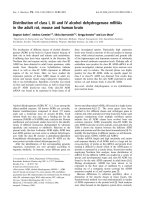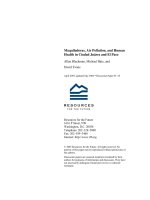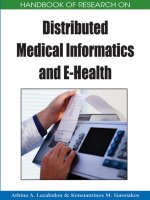DNA REPAIR AND HUMAN HEALTH ppt
Bạn đang xem bản rút gọn của tài liệu. Xem và tải ngay bản đầy đủ của tài liệu tại đây (23.98 MB, 806 trang )
DNA REPAIR AND
HUMAN HEALTH
Edited by Sonya Vengrova
DNA Repair and Human Health
Edited by Sonya Vengrova
Published by InTech
Janeza Trdine 9, 51000 Rijeka, Croatia
Copyright © 2011 InTech
All chapters are Open Access distributed under the Creative Commons Attribution 3.0
license, which permits to copy, distribute, transmit, and adapt the work in any medium,
so long as the original work is properly cited. After this work has been published by
InTech, authors have the right to republish it, in whole or part, in any publication of
which they are the author, and to make other personal use of the work. Any republication,
referencing or personal use of the work must explicitly identify the original source.
As for readers, this license allows users to download, copy and build upon published
chapters even for commercial purposes, as long as the author and publisher are properly
credited, which ensures maximum dissemination and a wider impact of our publications.
Notice
Statements and opinions expressed in the chapters are these of the individual contributors
and not necessarily those of the editors or publisher. No responsibility is accepted for the
accuracy of information contained in the published chapters. The publisher assumes no
responsibility for any damage or injury to persons or property arising out of the use of any
materials, instructions, methods or ideas contained in the book.
Publishing Process Manager Alenka Urbancic
Technical Editor Teodora Smiljanic
Cover Designer Jan Hyrat
First published October, 2011
Printed in Croatia
A free online edition of this book is available at www.intechopen.com
Additional hard copies can be obtained from
DNA Repair and Human Health, Edited by Sonya Vengrova
p. cm.
ISBN 978-953-307-612-6
free online editions of InTech
Books and Journals can be found at
www.intechopen.com
Contents
Preface IX
Part 1 DNA Repair Mechanisms 1
Chapter 1 DNA Repair, Human Diseases and Aging 3
Vaidehi Krishnan, Baohua Liu and Zhongjun Zhou
Chapter 2 Double Strand Break Signaling in Health and Diseases 47
Marie-jo Halaby and Razqallah Hakem
Chapter 3 DNA Damage Repair and Cancer: The Role of RAD51 Protein
and Its Genetic Variants 73
Augusto Nogueira, Raquel Catarino and Rui Medeiros
Chapter 4 The Role of Error-Prone Alternative Non-Homologous
End-Joining in Genomic Instability in Cancer 93
Li Li, Carine Robert and Feyruz V. Rassool
Chapter 5 Nucleotide Excision Repair and Cancer 121
Joost P.M. Melis, Mirjam Luijten, Leon H.F. Mullenders
and Harry van Steeg
Chapter 6 Recombinant Viral Vectors for Investigating DNA Damage
Responses and Gene Therapy of Xeroderma Pigmentosum
145
Carolina Quayle, Carlos Frederico Martins Menck
and Keronninn Moreno Lima-Bessa
Part 2 DNA Repair and Cancer 175
Chapter 7 DNA Damage, Repair and Misrepair
in Cancer and in Cancer Therapy 177
Ana M. Urbano, Leonardo M. R. Ferreira, Joana F. Cerveira,
Carlos F. Rodrigues and Maria C. Alpoim
Chapter 8 DNA Repair, Cancer and Cancer Therapy 239
Mu Wang
VI Contents
Chapter 9 DNA Repair, Cancer and Cancer
Therapy - The Current State of Art 279
Turgay Isbir, Berna Demircan, Deniz Kirac,
Burak Dalan and Uzay Gormus
Chapter 10 Application of UV-Induced Unscheduled
DNA-Synthesis Measurements in Human
Genotoxicological Risk Assessment 307
Anna Tompa, Jenő Major and Mátyás G. Jakab
Chapter 11 Hypoxia Inhibits DNA Repair to
Promote Malignant Progression 339
L. Eric Huang, Young-Gun Yoo,
Minori Koshiji and Kenneth K.W. To
Chapter 12 From the Molecular Biology to the Gene Therapy of
a DNA Repair Syndrome: Fanconi Anemia 349
Paula Río, Susana Navarro and Juan A. Bueren
Chapter 13 Fanconi Anemia/Brca Pathway and Head and
Neck Squamous Cell Carcinomas 373
Shi-Long Lu
Chapter 14 DNA Repair Deficiency Associated
with Hematological Neoplasms 385
Panagiota Economopoulou, Vassiliki Pappa,
Sotirios Papageorgiou, John Dervenoulas
and Theofanis Economopoulos
Chapter 15 DNA Repair in Acute Myeloid Leukemia
and Myelodysplastic Syndromes 411
Anna Szmigielska-Kaplon and Tadeusz Robak
Chapter 16 Therapeutic Modulation of DNA Damage
and Repair Mechanisms in Blood Cells 419
Haiyan Wang, Shanbao Cai, Eva Tonsing-Carter
and Karen E. Pollok
Chapter 17 DNA Repair Perspectives in Thyroid and Breast Cancer:
The Role of DNA Repair Polymorphisms 459
Susana N. Silva, Bruno Costa Gomes,
José Rueff and Jorge Francisco Gaspar
Chapter 18 DNA Mismatch Repair (MMR)
Genes and Endometrial Cancer 485
Kenta Masuda, Kouji Banno, Megumi Yanokura,
Iori Kisu, Arisa Ueki, Asuka Ono, Yusuke Kobayashi,
Hiroyuki Nomura, Akira Hirasawa,
Nobuyuki Susumu and Daisuke Aoki
Contents VII
Chapter 19 Human Apurinic/Apyrimidinic Endonuclease
is a Novel Drug Target in Cancer 495
Rachel M. Abbotts, Christina Perry and
Srinivasan Madhusudan
Chapter 20 Disruption of Protein–DNA Interactions:
An Opportunity for Cancer Chemotherapy 521
Tracy M. Neher, Wei Huang, Jian-Ting Zhang and John J. Turchi
Chapter 21 Pharmacogenomic Approach of Telomerase in Cancer:
Importance of End Zone Variability
R. Catarino, A. Nogueira, A. Coelho
and R. Medeiros
Chapter 22 Differential Effects of the G-Quadruplex Ligand 360A
in Human Normal and Cancer Cells 559
Christine Granotier and François D. Boussin
Chapter 23 Pharmacogenetics of Cancer and DNA Repair Enzymes 597
Tahar van der Straaten, Leon Mullenders and Henk-Jan Guchelaar
Part 3 DNA Repair and Aging 613
Chapter 24 Involvement of Histone PTMs in DNA Repair Processes in
Relation to Age-Associated Neurodegenerative Disease 615
Chunmei Wang, Erxu Pi, Qinglei Zhan and Sai-ming Ngai
Chapter 25 Transcriptional Functions of DNA Repair
Proteins Involved in Premature Aging 629
Robin Assfalg and Sebastian Iben
Part 4 DNA Damage and Disease 647
Chapter 26 DNA Damage and mRNA Levels of DNA Base Excision
Repair Enzymes Following H
2
O
2
Challenge
at Different Temperatures 649
Kyungmi Min and Susan E. Ebeler
Chapter 27 Relationship Between DNA Damage and Energy Metabolism:
Evidence from DNA Repair Deficiency Syndromes 661
Sarah Vose and James Mitchell
Part 5 Infection, Inflammation and DNA Repair 683
Chapter 28 The Role of DNA Repair Pathways in Adeno-Associated
Virus Infection and Viral Genome Replication /
Recombination / Integration 685
Kei Adachi and Hiroyuki Nakai
VIII Contents
Chapter 29 Integration of the DNA Damage Response
with Innate Immune Pathways 715
Gordon M. Xiong and Stephan Gasser
Chapter 30 Non-Steroidal Anti-Inflammatory
Drugs, DNA Repair and Cancer 743
Harpreet K. Dibra, Chris J. Perry and Iain D. Nicholl
Chapter 31 Inhibition of DNA Polymerase λ, a DNA Repair Enzyme,
and Anti-Inflammation: Chemical Knockout Analysis
for DNA Polymerase λ Using Curcumin Derivatives 777
Yoshiyuki Mizushina, Masayuki Nishida,
Takeshi Azuma and Masaru Yoshida
Preface
The genomic DNA of the cell is constantly under attack by the damaging agents from
variety of sources. Ultraviolet light, ionizing radiation and environmental chemicals,
as well as reactive oxygen species originating from the cellular metabolic processes,
stochastic breakage of bonds within the DNA molecules and programmed cleavage of
the DNA strands during differentiation all threaten the stability and integrity of the
genome.
Changes in the DNA sequence, be it single nucleotide substitutions, small deletions or
insertions, or rearrangements of large chromosomal fragments may disrupt the finely
tuned network of interactions within the cell. Such changes can result in cell death, or
in alterations in cellular growth and differentiation program. To prevent this, there is a
complex network of DNA repair pathways, which exists to ensure that the damage is
promptly detected and correctly repaired.
Over the last decades, great advances have been made in identifying the components
and dissecting interactions within the cellular DNA repair pathways. At the same
time, a wealth of descriptive knowledge of human diseases has been accumulated.
Now, the basic research into the mechanisms of DNA repair is merging with clinical
research, in particular with a fast developing field of clinical genetics, which has been
aided by the advancement of genome sequencing techniques. As a result, a new
picture is emerging, placing the action of the DNA repair pathways in the context of
the whole organism. Such integrative approach provides understanding of the disease
mechanisms and is invaluable for improving diagnostics and prevention, as well as
designing better therapies.
The central role of DNA repair in human health and well-being is illustrated by the
reviews presented in this book. Detailed descriptions of DNA repair pathways can be
found in several chapters. A large body of evidence addressing the link between DNA
damage repair and a number of diseases, such as cancers, Fanconi Anemia, Xeroderma
pigmentosa and Alzheimer’s is analysed. In addition, the role of DNA repair processes
in ageing, viral infection and the link between inflammation and DNA repair is
reviewed.
X Preface
The chapters are tentatively assigned to sections, however, many reviews touch upon
various aspects of DNA repair, so the titles of the sections by no means limit the scope
of individual reviews.
This book will be of interest to a broad audience. The biochemists, geneticists and
molecular biologists working on different aspects of DNA repair in any model system,
will gain an insight into the place of a particular DNA repair factor or pathway in the
context of the whole organism, while medical researchers will find a comprehensive
overview of the molecular mechanisms of DNA repair.
Dr. Sonya Vengrova
Warwick Medical School
University of Warwick
Gibbet Hill Campus
Coventry
United Kingdom
Part 1
DNA Repair Mechanisms
1
DNA Repair, Human Diseases and Aging
Vaidehi Krishnan, Baohua Liu and Zhongjun Zhou
Department of Biochemistry, The University of Hong Kong
Hong Kong
1. Introduction
One of the most fundamental functions of a cell is the transmission of genetic information to
the next generation, with high fidelity. On the face of it, this seems a challenging task given
that cells in the human body are constantly exposed to thousands of DNA lesions every day
both from endogenous and exogenous sources. Yet, for long periods of time, the DNA
sequences are one of the most invariable and stable components of a cell, a task achieved by
an arsenal of DNA damage detection and repair machinery that detects and fixes DNA
lesions with high fidelity at each and every round of cell division. In this chapter, we
describe how normal cells cope with DNA damage and the manner in which a defective
DNA damage response can lead to human disease and aging.
2. The types and sources of DNA damage
All livings cells of the human body have to constantly contend with DNA damage. Due to
its chemical structure itself, the DNA is sensitive to spontaneous hydrolysis which leads to
damage in the form of abasic sites and base deamination. Single strand breaks (SSBs) and
oxidative damage such as 8-oxoguanine lesions in DNA are generated by endogenous by-
products of metabolism like reactive oxygen species (ROS) and their highly reactive
intermediates. For example, it is estimated that about 100-500 8-oxoguanine lesions form per
day in a human cell (Lindahl, 1993). The formamidopyrimidine lesions, 2,6-diamino-4-
hydroxy-5-formamidopyrimidine (FapyG) and 4,6-diamino-5-formamidopyrimidine are
also formed at similar rates as 8-oxoG after oxidative stress. Spontaneous DNA alterations
may also arise due to dNTP misincorporation during DNA replication. Put together, it is
estimated that each human cell can face up to 10
5
spontaneous DNA lesions per day
(Maynard et al., 2009).
Apart from endogenous sources, DNA can also be damaged by exogenous agents from the
environment. These include physical genotoxic stresses such as the ultraviolet light (mainly
UV-B: 280-315 nm) from sunlight which can induce a variety of mutagenic and cytotoxic
DNA lesions such as cyclobutane-pyrimidine dimers (CPDs) and 6-4 photoproducts (6-
4PPs) (Rastogi et al., 2010). DNA damage in the form of double strand breaks (DSBs) can be
incurred as a result of medical treatments like radiotherapy, ionising radiation (IR) exposure
from cosmic radiation or as a result of the natural decay of radioactive compounds. For
example, uranium decay produces radioactive radon gas, which accumulates in some
houses to cause an increased incidence of lung cancer (Jackson and Bartek, 2009). Nuclear
DNA Repair and Human Health
4
disasters like the Chernobyl nuclear disaster, nuclear detonations during World War II or
more recently, the radiation leakage from the Fukushima power plant in Japan are examples
of other sources of severe exposure to exogenous radiation. Chemical sources of DNA
damage include chemotherapeutic drugs used in cancer therapy or for other medical
conditions. Alkylating agents such as methyl methanesulfonate (MMS) induce alkylation of
bases, whereas drugs such as mitomycin C, cisplatin and nitrogen mustard cause DNA
interstrand cross links (ICLs), and DNA intrastrand cross links. Chemotherapeutic drugs
like camptothecin and etoposide are topoisomerse I and II inhibitors respectively, and give
rise to SSBs or DSBs by trapping topoisomerase–DNA complexes. Other exogenous DNA-
damaging sources, that are carcinogenic as well, are foods contaminated with fungal toxins
such as the aflatoxin and overcooked meat products containing heterocyclic amines.
Another common source of environmental mutagen is tobacco smoke, which generates
DNA lesions in the form of aromatic adducts on DNA and SSBs (Jackson and Bartek, 2009).
3. DNA repair pathways
To maintain genomic integrity, a cellular machinery composed of multi-protein complexes
that are capable of detecting and signalling the presence of DNA lesions and delaying cell
cycle progression to promote DNA repair is activated, called as the DNA damage response
(DDR) (Harper and Elledge, 2007). To accomplish DNA repair, cells utilise biochemically
distinct pathways specific of the DNA lesion, which are integrated with appropriate
signalling systems to delay cell division until the completion of repair (Figure.1). Small
chemical alterations caused by the oxidation of bases is detected and repaired by the base
excision repair system (BER), through the direct excision of the damaged base. DNA
replication errors or polymerase slippage errors that commonly result in single base
mismatches and insertion-deletion loops are corrected by the mismatch repair system
(MMR). Lesions such as pyrimidine dimers and intrastrand cross links are corrected by the
nucleotide excision repair (NER) pathway. SSBs are removed by the SSB repair pathway
whereas DSBs are repaired by the DSB repair systems, which itself could be either by
homologous recombination (HR) or non-homologous end joining (NHEJ) pathway (Ciccia
and Elledge, 2010).
Fig. 1. Summary of DNA repair pathways
3.1 Base excision repair and single strand break repair
Base excision repair (BER) is the major pathway responsible for handling the mutagenic and
cytotoxic effects of DNA damage that can arise due to spontaneous hydrolytic, oxidative,
and non-enzymatic alkylation reactions. (Wilson and Bohr, 2007). This pathway focuses on
DNA Repair, Human Diseases and Aging
5
DNA lesions that do not tend to cause structural distortions of the DNA double helix. The
BER target lesions can be classified as oxidised/reduced bases such as 8-oxo-G/FapyG,
methylated bases, deaminated bases or bases mismatches. There are two types of BER: short
patch and long patch. During short patch BER, only the damaged nucleotide is replaced,
whereas in long patch BER, 2-6 new nucleotides are incorporated.
The very first step in BER involves the use of DNA glycosylases that cleave the N-glycosyl
bond between the damaged base and sugar to generate an abasic site, called as the AP
(apurinic/apyrimidinic) site. Similar AP sites may also arise due to the spontaneous
depurination or depyrimidination of bases. The DNA glycosylases that perform this
function are classified as monofunctional or bifunctional, depending on their mode of
action. Monofunctional glycosylases such as UNG only possess the glycosylase activity and
therefore a second enzyme called the APE1 lyase is required to cut base-free deoxyribose to
generate the 5’-deoxyribose phosphate termini (dRP). The next step involves the action of
DNA polymerase β (polβ) which removes the dRP group left behind by APE1 incision in the
short-patch pathway. However, if the 5’ terminal is refractory to polβ activity, strand
displacement synthesis is required in order to incorporate multiple nucleotides by long-
patch pathway. In this case, several enzymes such as proliferating cell nuclear antigen
(PCNA), FEN1 and polβ and/or polδ/ε act together to remove the blocking terminus. The
final step of BER consists of ligation of the remaining nick, by either Lig1 alone or Lig3–
XRCC1 complex (Maynard et al., 2009).
SSB repair pathway is a major pathway responsible for the repair of SSBs that arise directly
as a result of ROS-induced disintegration of oxidized deoxyribose or genotoxic stresses such
as IR. SSBs may also arise spontaneously due to the erroneous activity of DNA
topoisomerase 1 (TOP1). TOP1 creates a cleavage complex intermediate which contains a
DNA nick to allow DNA relaxation during DNA replication and transcription. Usually, the
nick generation is transient and is rapidly sealed by TOP1. However, if the nick
inadvertently collides with RNA polymerase, SSBs may be generated in the process. In
addition to the above scenarios where SSBs are generated directly within cells, SSBs may
also arise indirectly as BER intermediates due to the lyase activity of bifunctional
glycosylases such as OGG1 and NEIL1.
Single strand break repair (SSB) involves the activation of PARP (poly ADP ribose
polymerase) family members PARP1 and PARP2, which act as sensors of SSBs, through the
two PARP1 zinc finger motifs (Caldecott, 2008). Upon activation of PARP1 and PARP2,
poly (ADP-ribose) chains are synthesized within seconds, and assembled on target proteins
such as histone H1 and H2B and PARP1 itself (Schreiber et al., 2006). Histone PARylation
contributes to chromatin reorganization and helps in the recruitment of DNA repair and
chromatin remodelling proteins to DNA damage sites. Three types of PAR-binding motifs
have been identified: the PBZ (PAR-binding zinc finger), the macrodomain and an 8 amino
acid basic residue-rich cluster. Many DDR factors such as p53, XRCC1, Lig3, MRE11 and
ATM have the 8 amino acid basic residue-rich cluster, whereas macrodomains containing
proteins include PARP9, PARP14, PARP15, the histone variant macroH2A1.1, and the
chromatin remodeling factor ALC1. PBZ motifs have been identified in the nucleases APLF
and SNM1 and in the cell cycle protein CHFR.
Once SSBs are detected, they undergo end processing, where the 3’ and/or 5’ termini of
SSBs are restored to conventional 3’hydroxyl and 5’ phosphate moieties for gap filling and
DNA ligation to occur. XRCC1 has a particularly important role during DNA end
DNA Repair and Human Health
6
processing step, since XRCC1 directly interacts with enzymes such as pol β, PNK
(polynucleotide kinase) and the nucleases APTX and indirectly with DNA ligase III α and
TDP1 (tyrosyl-DNA phosphodiesterase) to facilitate end processing. Damage termini
present at indirect BER-induced SSB are repaired by APE1, Pol β, PNKP and APTX. Direct
sugar damage-induced SSBs are repaired by APE1, PNKP and APTX. SSBs generated by
TOP1 are repaired by TDP1. Finally, end processing is followed by gap filling and ligation,
and the enzymes utilized during these two steps overlap with BER (as described above).
It is interesting that ~30% of all human tumors examined express a variant form of DNA
polymerase β (Starcevic et al., 2004) Moreover, at least two proteins, TDP1 and APTX,
involved in SSB repair are mutated in an inherited form of human neurodegenerative
disease (discussed in Section 5.1).
3.2 Mismatch repair
The replication of DNA sequences in the S phase of cell cycle is subjected to a low but
significant level of error that includes the inadvertent incorporation of chemically altered
nucleotides in place of the normal counterparts. The cell has two main strategies to detect
and remove the miscopied nucleotides. In a ‘proofreading’ type of monitoring executed by
the DNA polymerase δ (pol- δ), the stretch of DNA that has been newly synthesized is
scanned, and if misincorporation of nucleotides is detected, the enzyme uses it 3’-5’
exonuclease activity to remove the aberrant nucleotide and resynthesize the DNA stretch.
However, if the miscopied DNA sequence is overlooked by DNA pol-δ, the MMR pathway
is activated that detects and corrects misincorporated nucleotides. The action of this
pathway becomes especially critical in regions of DNA that carry repetitive sequences such
as mono or dinucleotide repeats. The resulting base substitution mismatches and insertion-
deletion mismatches (IDLs) may escape correction by the proofreading mechanism
described above, making the repair of such defects the prime function of the MMR
machinery (Kunkel and Erie, 2005).
The ‘Mut’ proteins are the principle active components of the mismatch repair pathway
(Kolodner and Marsischky, 1999). The main function of the Mut proteins lies in the ability to
detect bulges and loops in the newly formed DNA and in being able to distinguish between
recently synthesized DNA from the complementary parent strand. In mammalian cells, two
components of the MMR apparatus, MutS and MutL collaborate to correct mismatched
DNA. MutS homologs form two major heterodimers, Msh2/Msh6 (MutSα) and Msh2/Msh3
(MutSβ) which scan for the mismatched base on the newly formed daughter strand and
bind directly to the mutated DNA. The main difference between the two MutS complexes is
that MutSα pathway is mainly involved in the repair of base substitution and small loop
mismatches, while the MutSβ pathway is also involved in large loop repair. After the
recruitment of MutS, MutL dimer is loaded to the mutated site through its binding to the
MutS-DNA complex. MutL has three forms designated as MutLα, MutLβ, and MutLγ. The
MutLα complex is made of two subunits MLH1 and PMS2, the MutLβ heterodimer is made
of MLH1 and PMS1, while MutLγ is made of MLH1 and MLH3. MutLα is an endonuclease
that facilitates strand-discrimination and nicks the discontinuous strand of the mismatched
duplex in a PCNA, RFC and ATP-dependent manner. Lastly, the excision reaction is
performed by the 5′–3′ single-stranded exonuclease EXO1, whose exonuclease activity is
increased by its direct interaction with MutSα. The resulting fragment is excised and a fresh
DNA Repair, Human Diseases and Aging
7
attempt at resynthesizing DNA using DNA pol-δ is made using the parent strand as the
template (Fukui, 2010; Larrea et al., 2010).
The MMR pathway is particularly important in mammals, where the mutator phenotype
conferred by loss of MMR activity contributes to the initiation and promotion of multistage-
carcinogenesis (Venkatesan et al., 2006)
3.3 Nucleotide excision repair
The activation of NER pathway seems to require two distinct structural changes in DNA: a
significant distortion to the native conformation of DNA and the presence of a chemically
altered base. NER is accomplished by a large multisubunit complex composed of almost two
dozen subunits. NER comprises of two distinct subpathways that mainly differ in the
molecular mechanism used to identify the damaged base. Global genome repair (GGR)
repairs DNA damage throughout the genome, whereas transcription-coupled repair (TCR)
repairs lesions in regions that are undergoing transcription (Nouspikel, 2009).
Historically, the NER pathway was discovered through the study of a human syndrome
involving a severe burning of the skin after only a minimal exposure to sun light. These
individuals show dry, parchment like skin (Xeroderma) and freckles (pigmentosa).
Individuals suffering from Xeroderma Pigmentosa (XP) have a 1000-fold greater risk of
developing skin cancers and inherited defects in any of the so-called XP genes cause this
syndrome. Subsequently, elegant somatic cell genetic experiments were performed and
seven genetic complementation groups of the human XP, designated XPA to XPG were
identified in mammalian cells. According to current understanding, two independent
complexes, one composed of the DDB1/DDB2 heterodimer, and the other containing the
XPC/HR23B/Centrin 2 proteins are required for the early steps of base damage recognition
during NER (Guo et al., 2010; Nouspikel, 2009).
UV-damaged DNA-binding protein (UV-DDB) is a heterodimeric complex composed of
DDB1 and DDB2 which upon binding to UV-damaged sites activates a UV-DDB-associated
ubiquitin ligase complex that recruits XPC protein to the lesion and promotes ubiquitination
of DDB2 and XPC proteins (Sugasawa et al., 2005). Upon polyubiquitination, DDB2 loses its
ability to bind to UV-irradiated DNA, whereas XPC upon ubiquitination shows increased
DNA binding. In turn, XPC recruits the multiprotein transcription-repair complex called as
the TFIIH (transcription factor IIH). Subsequent recruitment of RPA and XPA drive
detachment of cyclin-dependent kinase activating (CAK) subcomplex of TFIIH which is
essential for GGR. The two helicases within the TFIIH complex (XPB and XPD) unwind the
DNA by about 20 bp around the damage to form a stable complex called pre-incision
complex 1 (PIC1). Localized unwinding around the damaged base then leads to the exit of
XPC-HR23 and the entry of XPG to form PIC2. Finally, XPF-ERCC1 is recruited to form
PIC3. At each of these steps ATP is hydrolyzed, and the free energy of ATP hydrolysis is
used to unwind the helix as well as to amplify the damage recognition specificity of the
enzyme system. Within PIC3, XPG and the ERCC1/XPF complex are both structure-specific
endonucleases that carry out dual excision and cut the damaged strand of DNA 3′ and 5′ to
the lesion, respectively. This generates a single-stranded oligonucleotide 24–32 nucleotides
in length. The incisions are asymmetrical, such that the 3′ incision occurs 2 to 8 nucleotides
from the damaged base and the 5′ incision occurs 15 to 24 nucleotides from the damaged
base. The resulting gap is filled in by the combined actions of DNA polymerase δ or ε,
proliferating cell nuclear antigen (PCNA), RPA, and DNA ligase I (or a complex of
XRCC1and DNA ligase III) (Hanawalt and Spivak, 2008).
DNA Repair and Human Health
8
Bulky lesions consisting of UV-induced pyrimidine dimers in transcribed regions can lead to
RNA polymerase II stalling, evoking the activation of TCR. In TCR, the stalled RNA
polymerase is removed and DNA damage is repaired, through a process initiated by the
Cockayne syndrome proteins, CSA and CSB. The CSA protein belongs to the ‘WD repeat’
family of proteins and exhibits structural and regulatory roles while CSB protein which is an
ATP-dependent chromatin remodelling factor in the SWI/SNF family. CSB, in turn recruits
additional factors such as the histone acetytransferase p300, the CSA-DDB1 E3
ubiquitin/COP9 signalosome complex (O'Connell and Harper, 2007). Similar to GGR, the
subsequent steps involve the binding of TFIIH and XPA/RPA to the lesion and the
nucleases XPG and XPF/ERCC1 carry out the incision 3’and 5’ to the damaged lesion. The
generated oligonucleotide is removed and the gap is filled in by the combined action of
DNA polymerases δ or ε, PCNA, RPA, and DNA ligase I or XRCC1/ DNA ligase III.
3.4 DNA replication stress and ATR
Replication stress is a unifying term used to denote large unprotected regions of ssDNA
generated during the course of DNA replication or formed at the resected region of DSBs
(Lopez-Contreras and Fernandez-Capetillo, 2010). Both situations converge with the
generation of a RPA-coated ssDNA intermediate which is the triggering signal for the DNA
replication checkpoint. The ssDNA-RPA complex plays two critical roles: it recruits ATR by
directly binding to the ATR partner, ATRIP. Secondly, it recruits and activates the Rad17
clamp loader which then loads the PCNA-like heterotrimeric ring 9-1-1 (Rad9-Hus1-Rad1)
complex to DNA. The 911 complex binds to the ATR activator TopBP1, thus bringing it in
close proximity to ATR-ATRIP, leading to ATR activation. Once activated, ATR initiates the
DNA replication checkpoint through the phosphorylation of its downstream substrates. In
addition to replication checkpoint signalling, ATR is also required for stabilization of stalled
replication forks. In the absence of ATR, forks undergo a ‘collapse’ and are unable to resume
replication upon the withdrawal of replication stress (Friedel et al., 2009). The absence of
ATR also results in a specific type of genomic instability, named as DNA Fragile site
expression. DNA fragile sites (DFS) are large (>100 Kb) genomic regions that exhibit breaks
under conditions of replication stress. DFS sites are ‘hot spots’ for sister chromatid
exchanges and are involved in gene amplification events via a breakage-fusion-bridge cycle.
Breakage at DFS is associated with several cancers (Dillon et al., 2010).
3.5 Interstrand cross link repair (ICL repair)
ICLs are generated by cross linking agents like mitomycin C and these lesions covalently
connect the two strands of DNA to form a barrier to replication fork progression. Important
components of the ICL repair pathway are 13 genes mutated in the genetic syndrome,
Fanconi anemia (FA). FA is an autosomal recessive cancer predisposition disorder
characterized by progressive bone marrow failure, congenital developmental defects,
chromosomal abnormalities and hypersensitivity to ICL agents (Kitao and Takata, 2011).
The gene products of FA constitute a common pathway called the FA pathway, whose main
role is in the repair of ICL lesions to maintain genomic integrity (Moldovan and D'Andrea,
2009). Eight of the FA proteins (FANCA, B, C, E, F, G, L and M) form the so-called FA core
complex, an E3 ubiquitin ligase that monoubiquitinates downstream FANCD2-FANCI
dimer. The core complex also incorporates FAAP100 and FAAP24 and the heterodimer
MHF1/MHF2 as crucial components. Upon monoubiquitination, the ID complex
DNA Repair, Human Diseases and Aging
9
accumulates at the sites of crosslinks and co-localizes with three additional FA proteins,
Brca2 (FANCD), PALB2 (FANCN), and BACH1 (FANCJ). Monoubiquitinated ID complex is
required for the incision and translesion synthesis steps of ICL repair by promoting the
recruitment of DDR factors required for ICL repair (Moldovan and D'Andrea, 2009).
Recently, another level of regulation was revealed in the FA pathway, in that ID complex is
phosphorylated first by ATR and this step was shown to be critical for further
monoubiquitination by the core complex. Subsequently, factors required for HR are also
recruited to repair the DSBs generated during the repair process. Thus, ICL repair requires
the coordinated recruitment and concerted action of several DNA repair pathways.
3.6 Double strand break repair
DNA double strand breaks are the most deleterious type of DNA damage and cells have
evolved at least four types of repair pathways to detect and correct DSBs. These pathways
include homologous recombination (HR), non-homologous end joining (NHEJ), alternative
NHEJ pathway. The main factor influencing pathway choice is the extent of DNA
processing. While NHEJ does not require DNA end resection, HR and alternative NHEJ
pathways are dependent on end resection (Ciccia and Elledge, 2010).
NHEJ is an error-prone process, where broken ends are recognised and sealed together and
mainly occurs in G0, G1 and early S phase of the cell cycle and requires the DNA-PK (DNA
protein kinase) complex and the Lig4 complex (Lieber, 2010). The DNA-PK complex consists
of the Ku70 and Ku80 heterodimer which recognises and binds to the DSB and recruits
DNA-PKcs, the catalytic subunit of DNA-PK. Following DSB binding, DNA-PKcs
autophosphorylation on the six-residue ABCDE cluster (T2609) causes destabilization of the
DNA-PKcs interaction with DNA thus providing access to end processing enzymes such as
ARTEMIS (Goodarzi et al., 2006). On the other hand, to prevent excessive end processing,
DNA-PKcs is also autophosphorylated at the five-residue cluster called as the PQR cluster at
S2056, which helps protect DNA ends. Thus, two reciprocally acting phosphorylation
clusters regulate end processing by DNA-PKcs (Cui et al., 2005).
Following the recognition of DSBs, ends must be transformed into 5’phosphorylated
ligatable ends to complete repair. One key enzyme required for end processing is ARTEMIS,
which might be recruited to DSBs through its ability to interact with DNA-PKcs. End
processing is also carried out by APLF nucleases and the PNK kinase/phosphatase prior to
ligation (Mahaney et al., 2009). Next, the end processing of complex lesions might lead to the
generation of gaps which are filled in by DNA polymerase μ, polymerase λ and terminal
deoxyribonucleotidyltransferase. The final step involves the ligation of DNA ends, a step
carried out by X4-L4 (a complex containing XRCC4, DNA ligase IV and XLF) (Hartlerode
and Scully, 2009).
Interestingly, when the classical NHEJ pathway is inhibited, an alternative end-joining
pathway operates in cells. This substitution is called as alternative end joining (alt-EJ),
backup NHEJ (B-NHEJ) or microhomology mediated end joining (MMEJ) (Lieber and
Wilson, 2010). This pathway functions even in the absence of classical NHEJ factors such as
Ku, XRCC4 or DNA ligase IV. For example, the alt-NHEJ pathway is robustly activated in
mice lacking X4-L4. Alt-NHEJ is mediated by the annealing of ssDNA microhomology
regions followed by LIG3-dependent DNA end ligation (Ciccia and Elledge, 2010;
Hartlerode and Scully, 2009). Microhomologies are short stretches of complementary
“microhomology” sequences (1–10 base pairs) that often appear at repair junctions. This
suggests that even limited base pairing between two ends of a double-strand break is
DNA Repair and Human Health
10
exploited during alt-NHEJ repair (Lieber and Wilson, 2010). Alt-NHEJ pathway is error-
prone and frequently results in small deletions/insertions around the region of double
strand breaks or could even result in deleterious translocations (Zhang and Jasin, 2011).
Unlike NHEJ, HR is an error-free process that involves the use of the undamaged
homologous sister chromatid as the template to facilitate DNA repair of the damaged strand
and is carried out in cells that are in the late S and G2 phases of cell cycle (Moynahan and
Jasin, 2010). Homologous recombination (HR) provides an important mechanism to repair
double strand breaks during mitosis and meiosis. Defective HR can potentially transform
cells by disrupting their genomic integrity. HR involves the detection of DSB by the MRN
(MRE11-Rad50-NBS1) complex which promotes activation of ATM (Ataxia-telangiectasia
mutated). In addition to stabilizing DNA ends, MRE11 has endonuclease and exonuclease
activities which are important to mediate 5’-3’ resection along with CtIP to generate single
strand DNA (ssDNA). ssDNA is coated by the ssDNA-binding protein, RPA which is a
heterotrimeric complex (RPA1, RPA2, RPA3) that stabilizes ssDNA regions generated
during both DNA replication, repair and recombination. At the double strand break, the
RPA-coated ssDNA recruits ATR-ATRIP to chromatin, an event critical for the activation of
the ATR-chk1 pathway. Similar to the trimeric RPA complex, the newly identified human
ssDNA binding protein, hSSB1 is thought play a role in checkpoint activation and repair
(Richard et al., 2008). The next critical step in HR is the assimilation of Rad51 to ssDNA in a
Brca2 and PALB2 (Partner and localizer of Brca2) dependent manner to form the Rad51-
coated nucleoprotein filament. Rad51-mediated homology search and strand invasion
follows where the Rad51 recombinase utilizes the sister chromatid as the homologous
template and together with Rad51 paralogs (Xrcc2, Xrcc3, Rad51L1, Rad51L2 and Rad51L3),
Rad52 and Rad54 promotes strand invasion and recombination. Strand invasion and
migration involve the formation of a structure termed as the Holliday junction. Following
DNA polymerase δ-mediated DNA synthesis, resolution of Holliday junction occurs via
Rad54/Mus81/Emc1 and Rad51C/Xrcc3 (San Filippo et al., 2008).
It is now becoming increasingly clear that the choice between the various DNA repair
pathways is dictated by negative regulation of on one pathway by another. For example,
DSB resection promoted by CtIP is inhibited by 53BP1 (Bunting et al., 2010). 53BP1 itself
promotes NHEJ by increasing the stability of DSBs during ligation. Another example of this
regulation was highlighted by a recent study where defective DSB resection in Brca1 mutant
cells results in NHEJ-dependent chromosomal rearrangements which could be overcome by
53BP1 loss, suggesting that Brca1 might somehow overcome 53BP1 function at DSBs to
promote HR (Bunting et al., 2010). Also, abnormal activity of alt-NHEJ in the absence of
NHEJ induces chromosomal translocation in mammalian cells (Simsek and Jasin, 2010).
Thus, the right choice of DSB repair pathways can be a critical determinant of genomic
stability and alterations in the appropriate repair pathway choice can lead to DSB repair
defects with deleterious consequences.
3.7 Double strand break signalling
Amongst the various classes of DNA repair, perhaps the best studied pathway with respect
to DNA lesion sensing and signalling is the DSB repair signalling response. The response to
DSBs has been characterised by the rapid localization of repair factors to DSB sites into
subnuclear foci called ionizing radiation-induced foci (IRIF) (Bekker-Jensen and Mailand,
2010). At a more mechanistic level, the DDR proteins can be divided into three major classes
DNA Repair, Human Diseases and Aging
11
of proteins that act together to translate the DNA damage signal into an appropriate
response. These consist of (a) sensor proteins that recognize abnormal DNA lesions and
initiate the signalling cascade (b) transducers that amplify the damage signal and (c)
effectors proteins that participate in a number of downstream pathways such as cell cycle,
apoptosis and senescence (Figure 2: DNA damage signalling and response) (Jackson and
Bartek, 2009).
Fig. 2. Basic organization of the DNA damage response: Sensors, transducers and effectors
3.7.1 Sensing the damage
The efficient sensing of DSBs is achieved by Mre11-Rad50-Nbs1 (MRN) protein complex
(Stracker and Petrini, 2011). The MRE11 (Meiotic Recombination 11) protein is an
evolutionarily conserved protein that is involved in HR, NHEJ, meiosis and in the
maintenance of telomeres. RAD50 is a homolog of S.cerevisiae Rad50 and is a member of the
structural maintenance of chromosome (SMC) protein family. The third protein in the MRN
complex is NBS1 (Nijmegen breakage syndrome 1) protein also known as Nibrin and p95.
Structural and biochemical studies have elucidated the architecture of the MRN complex
and have proposed the biochemical events that lead to the activation of the DDR. The key
protein in the MRN complex is the Mre11 homodimer. This protein has the ability to bind
free DSBs and also has an intrinsic 3’-5’ exonuclease activity that can help in the resection of









